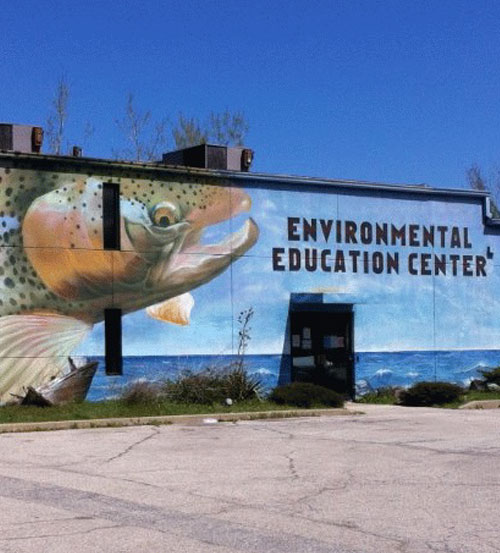Looking across Wolf Lake from Illinois to Indiana.
Photo by Rod Sellers

Looking across Wolf Lake from Illinois to Indiana.
Photo by Rod Sellers
Wolf Lake is a natural lake, but many areas were dredged in years past. It is separated into nine different sections or ponds by dikes left after completion of the dredging project of the 1950s to construct the Indiana Toll Road span across the lake. Today, the lake’s maximum depth is about 20 feet; average depth is about 8.5 feet. More than a century ago, the average depth was 2.5 feet with a maximum depth of about 5 feet.
Wolf Lake straddles the Illinois and Indiana state line. It is not known how the area originally became known as Wolf Lake. Some local residents claim that Wolf was an early settler. Others say the lake was named after Noaway, the son of Potawatomi Indian chief Ashkum, who lived in the early 1800s. Noaway translated into English is Wolf. Still others say that years ago wolves were abundant around the lake and that the lake itself was in the shape of a wolf. The Chicago Historical Society was unable to verify any of these possibilities.
The lake and adjacent wetlands provide nesting habitat for four species of endangered birds: yellow-headed blackbird, little blue heron, yellow-crowned night heron, and black-crowned night herons. Wetlands also shelter the threatened marsh speedwell and endangered carex garberi sedge. The endangered lake sturgeon and threatened banded killifish, spotted sunfish and Iowa darter also inhabit the waters of Wolf Lake.
This tour points to the future, so AWLI hopes those taking the tour will bring along their visioning powers. Sometimes one needs to envision a late spring day; at other times a cold winter morning would be in order. But AWLI will weave the past into the present, at times traveling from a green belt to a rust belt and back to a green belt along the spectrum of time.

Home to AWLI between 2004 and 2014, the Environmental Education Center in Hammond is operated by the Lake County Solid Waste Management District and has been the venue for many AWLI events.
Photo by Michael Boos
Directions From the Chicago Loop, travel south on the Dan Ryan expressway to the Chicago Skyway. Exit Skyway at 104th Street, continue southeast on Indianapolis Boulevard, which is Highway Route 41, for about a mile. At the third stop light, turn right onto Calumet Avenue, drive south in the left lane for about another mile. As you pass a building painted blue, take a left into the parking lot of the Environmental Education Center (EEC), 2405 Calumet Ave., Hammond.
For those traveling from Cline Avenue, take Columbus Drive west to Indianapolis Boulevard., and turn right and then left at 129th Street. After about a mile, turn right onto Calumet Avenue and you will see the Center to your right.
The Center is located between Wolf Lake Park and George Lake. Operated by the Lake County Solid Waste Management District, the EEC provides environmental education to local school students and youth groups. It features a classroom, laboratory and indoor trout stream in which generations of rainbow trout live. The building also houses Hammond’s Arts and Crafts Reuz Station where items are received and stored and then made available for reuse by such nonprofit groups as schools, scout troops, 4-H groups and churches. AWLI’s headquarters was located at the Environmental Education Center from 2004 to 2014.
From the EEC, drive south. At the stop light, turn right and then another right and enter parking lot. Walk behind the concert pavilion and along the shoreline or onto the pier.